With hundreds of success stories behind it, this step-by-step sourdough starter recipe shows you how to create your own bubbly starter in six days, no fancy tools required. Perfected over years of testing, this easy method is foolproof!
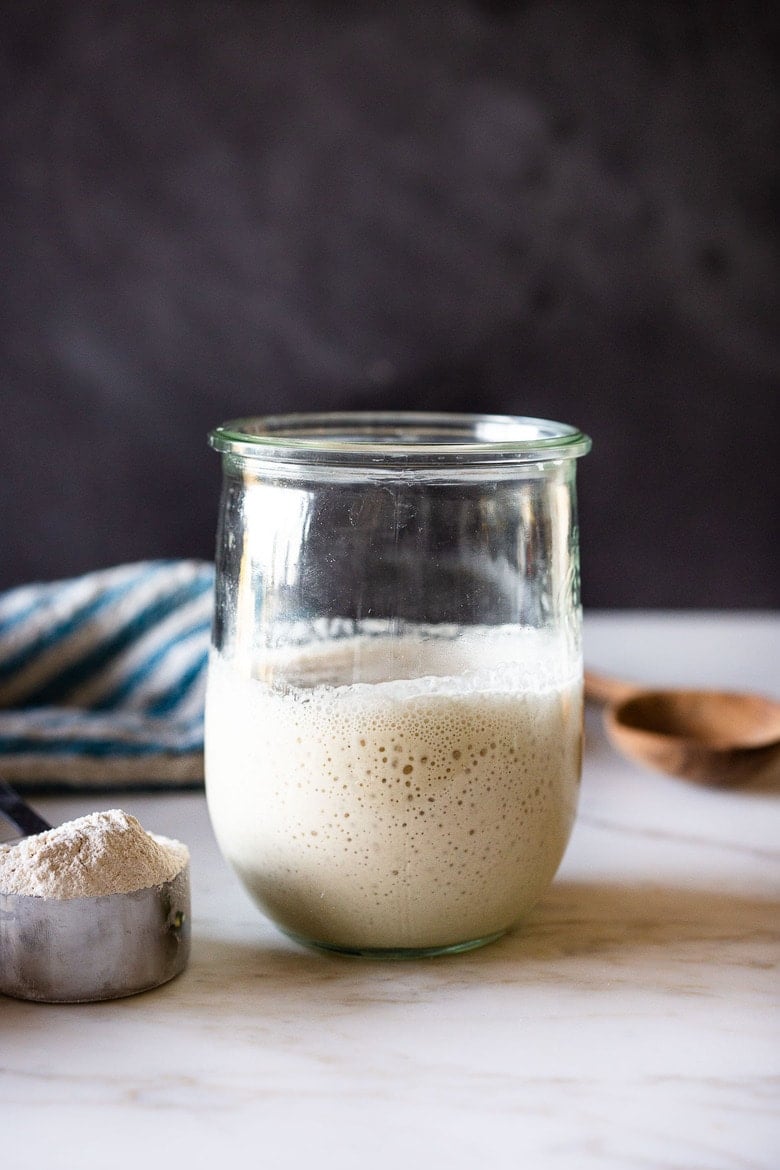
When you understand one thing through and through, you understand everything.
Shunryu Suzuki
With over 500 five-star reviews and hundreds of success stories, my chef's perfected sourdough starter guide has everything you need to make your own homemade starter. It is an easy process, and once you understand it, you’ll think to yourself, Why didn’t I do this sooner! In just six days, you'll be baking the most beautiful sourdough bread! Just read all the success stories below.
What is Sourdough starter?
Sourdough starter is a “wild yeast” made from flour, water, and the natural wild yeast in the air. With a little care and patience, it ferments, and when strong and active, just a little bit of starter replaces commercial yeast and makes your bread rise, while transforming the gluten in the bread into something more easily digestible. Store-bought yeast is not needed!
How long will it take?
It takes 6-7 days to make sourdough starter from scratch. In colder climates, it can take up to 12 days, and in warmer climates, it may only take 5 days. Once you have a bubbling active starter that consistently rises and falls, you can bake sourdough bread, typically on day 7. For a primer, watch the 20-minute Sourdough Video below, where I personally walk you through each day.
Watch: How to Make Sourdough Starter From Bread Flour
Fast forward to Specific Day by video time (using scroll bar underneath video)
- Day 1 Morning: :23
- Day 2 Morning: 4:10
- Day 3 Morning: 7:00
- Day 3 Evening: 9:12
- Day 4 Morning: 11:50
- Day 4 Evening: 13:37
- Day 5 Morning: 14:45
- Day 6 Evening: 16:50
- Day 6 Morning: 18:12
- Day 6 Evening: 20:10
Best Sourdough Starter Ingredients
Sourdough Starter Equipment
- Jar – A wide-mouth quart jar or a Weck’s 1-liter tulip jar.
- Kitchen Scale – using a kitchen scale helps measure the flour and water more accurately – optional but handy.
- Thermometer – Knowing the temperature of the starter using a thermometer gives you great information!
Sourdough Starter Ingredients
- Flour – 5 lb bag of organic bread flour (plus 1-2 cups organic whole grain flour like rye flour or whole wheat flour). All-purpose flour is not reccommended. Whole grain flour has more wild yeast- and will help jump start your starter!
- Water – filtered water, tap water, or mineral water (specifically, San Pellegrino, for the correct mineral ratio). Distilled water does not have enough minerals.
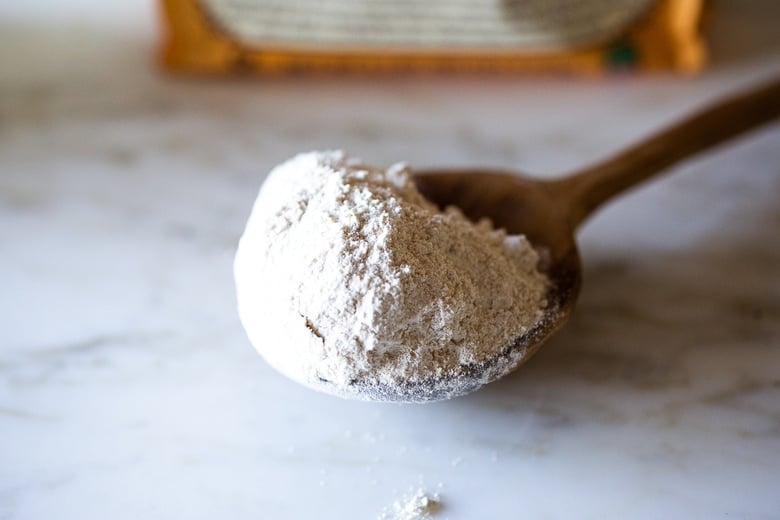
Understanding Your Sourdough Starter
The secret to making sourdough starter is understanding the process, your environment and your starter’s needs. Each starter is different and unique. Here, we’ll show you what to look for and most importantly, why.
- Think of sourdough starter as a yeast. Only in this case, instead of buying a packet of yeast from the store, you are making your own living “wild yeast” by fermenting flour and water. Once it’s bubbly and happy, it is very much like a very low-maintenance pet. Yes, you can even name it. Mine is called Vita.
- You must feed it (stir in a mixture of flour and water) once a week to keep your pet active and strong. We will show you how to tell when it is hungry and when to feed it.
- Some people believe that bread made with sourdough starter is actually better for you than bread made with yeast. Here and here are a few articles to get you started on your own research. While I’m not sure if this is scientifically proven, I do know that bread made with sourdough starter, tastes infinitely better, feels easier to digest, and has more complexity and better texture than bread made with commercial yeast. So if you are a bread lover, this is absolutely the way to go, as far as the quality of your finished bread.
How to Make Sourdough Starter from Bread Flour
*See the recipe card for detailed instructions.
For your first measurement, weigh the flour using a kitchen scale so you can get an idea of how the mixture should feel. Do not weigh the measuring cup! It should be like a thick paste, like peanut butter. If you need to add a little more water to incorporate the flour, that is OK too.
Day 1: Starting in the morning or at night, using a wide-mouth quart jar, tulip jar, mix 1 cup whole grain flour (120 grams) with 1/2 cup filtered water (120 grams) using a fork, making sure you’ve incorporated all the dry flour.
Place the lid lightly on top (using the Weck jar lid is really handy here) or a wet towel to keep moisture in, or plastic wrap- and let sit at room temperature (70-ish degrees) on the kitchen counter for 24-48 hours. If you are unsure how warm it is, use a kitchen thermometer and check it a few hours later. It is best at 70-75°F.
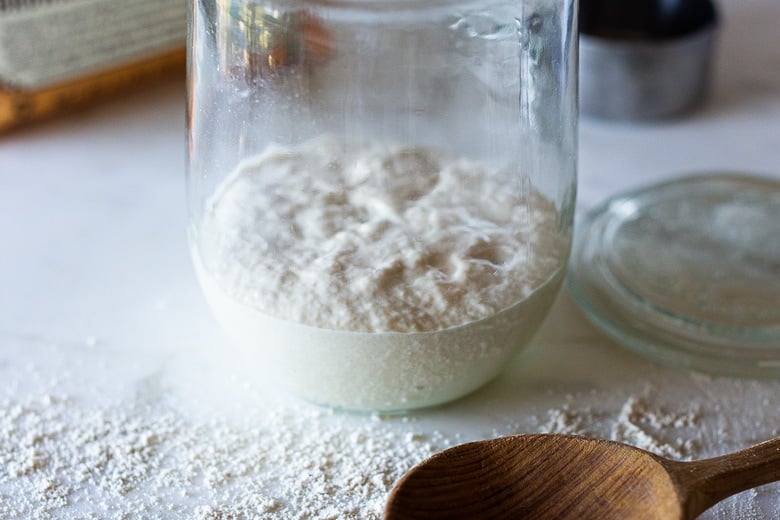
Day 2: After the first 24 hours, there may or may not be a bit of bubbling. Let the mixture rest until you see activity (bubbles or rising). Sometimes this takes 36 hours or even 48 hours, especially if the weather is very cold. When you see active bubbling, discard all but 1/2 cup of the starter (4 ounces).
To the remaining ½ cup of starter, stir in 1/2 cup lukewarm water (120 grams), and mix well with a fork. Add 1 cup of organic bread flour (120 grams) spooned and leveled. Stir until combined. Again, it should feel like a thick paste. If overly dry, feel free to add a bit more water. Cover again and allow the mixture to sit at room temperature for another 24 hours.
Day 3: After 24 hours, hopefully, you will see some bubbling or rising, and if not, let it go longer until you see some activity. Be patient. Depending on how warm your house is and how active your starter, you may need to feed it less often or more often, depending on when it gets “hungry”.
How to Know when to Feed your starter
Only feed your starter after it has peaked or looks “hungry”. Feeding it when it is “not hungry” will basically dilute all the growing yeast and make it lethargic. Better to underfeed than overfeed. How to tell if it is hungry?
- Look for “slide marks” (be sure to use a clean jar so you can see these clearly-see photo below).
- Thin and runny. The starter is liquid enough to pour out of the jar (when at room temperature).
- There is liquid at the top of the starter- a clear sign of hunger!
- Smells like acetone. The starter has processed all of the previous feeding and needs to be fed again.
In the photo below, the starter “peaked” at the top line, then slid down. I call these slide marks- indicating the starter is hungry.

This might be 12 hours, it might be 14, it might be 18, or 24, depending on the temp in your house. In very warm climates, it may only be 6-8 hours. In winter, this may take 36 hours. It is better to underfeed rather than overfeed.
For each feeding, discard all but 1/2 cup of the starter (keeping roughly ½-cup of starter in the jar). Add 1/2 cup water and 1 cup bread flour (spooned and leveled). Mix well, cover, and let this rest at room temperature for 12-24 hours or until the starter looks “hungry” again before repeating.
Day 4: Feed 1-2 times a day (only feeding when hungry), discarding all but 1/2 cup of starter each time. Feed 1 cup of bread flour and 1/2 cup of water.
TIP: It is typical on day 4 for the starter to slow down and stall a bit. This is OK. Just keep going, be patient, and look for the hunger signs, and only feed when clearly hungry. Hopefully, you’ll begin to see some rising and falling. It’s helpful to put the starter in a clean jar each day and mark the beginning level (with a sharpie, string or rubber band) so you can easily see this.
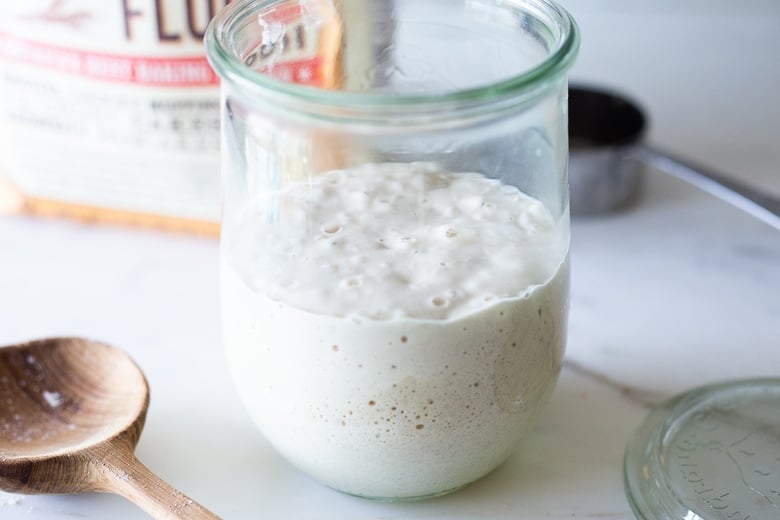
Above, you’ll see it peaking, and below, you’ll see it deflating and getting “hungry.” There may not be too much difference in the beginning, so look closely.
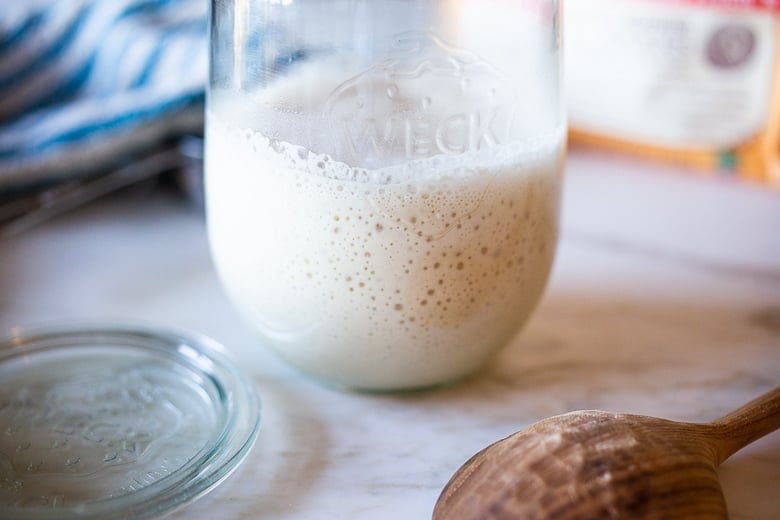
Understand that your starter has a schedule of its own; it is a living thing, so watch it and pay attention.
If your starter is not rising and falling, look at its consistency. As it metabolizes the flour and gets hungry, it will get runny and liquidy, like to the point where you can pour it right out of the jar. If it is still thick like paste, it’s not done metabolizing (eating) the flour.
Day 5: Feed again, 1-2 times, discarding all but a 1/2 cup of the starter each time. Add 1 cup of bread flour and 1/2 cup of lukewarm water. The starter should look visibly active, bubbling, rising, hopefully, close to doubling in size.
*Repeat day 5 until the starter is rising and falling predictably and is close to doubling in size within 6-8 hours.
If your starter is not rising but there is evidence of hunger (runny or liquid at the top), try these three things:
- Substitute 1/4 cup whole grain flour (add to ¾ cup white bread flour) on your next feeding.
- Use mineral water like San Pellegrino instead of water.
- Stir the starter a few times after feeding to allow more wild yeast from the kitchen to get inside.
DAY 6 Morning: Baking day! Give it one last feeding in the morning: this time discard all but a 1/3 cup. (The reason we are changing this to 1/3 cup is to feed it a little bit more.) Add 1 cup flour (120 grams) and 1/2 cup water, stir, and place it in a clean jar so you can see the activity clearly. You can use a Sharpie or place a rubber band around the jar to mark the beginning level.
How to Know When Your Bread Flour Sourdough Starter is Ready to Bake Bread
The starter should double in volume within 6-8 hours of feeding.
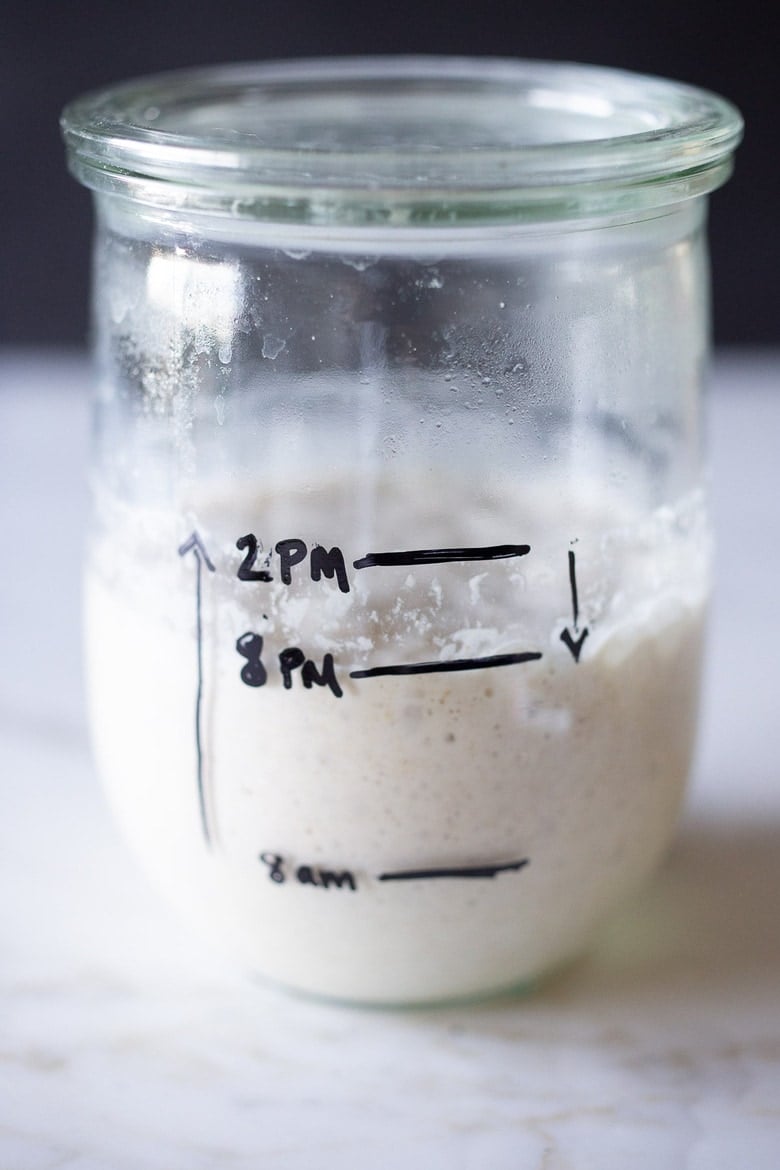
In the photo above, on the 6th day, the starter was fed at 8 am, it peaked around 2 pm, then it started deflating, and by 8 pm, it was “hungry” again. See those downward “slide” marks on the jar?
Do the Float Test
When the starter is at its peak, or just after, place a teaspoon of starter (just from the top, don’t stir it down) in a glass full of water; it should hopefully float. If it floats, success! Congrats. You can now make our sourdough bread…tonight!
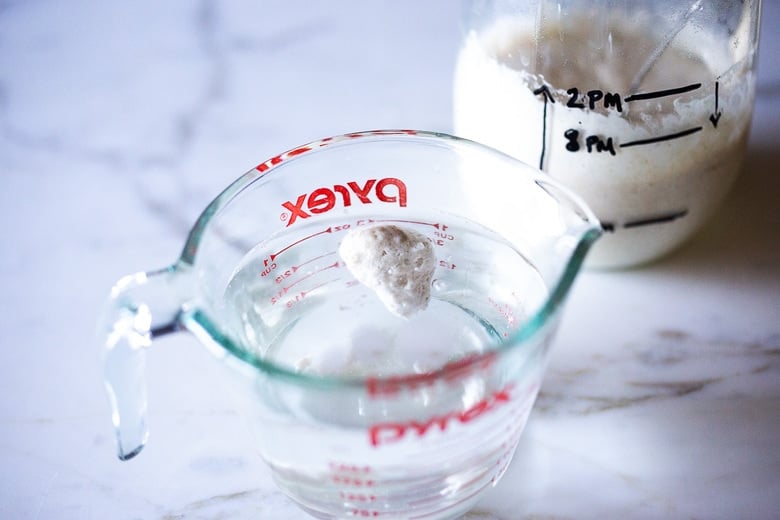
My Best Sourdough Baking Tip. When baking bread, always use a hungry starter that has already peaked.
STARTER DOES NOT FLOAT? If it doubles in size but does not float, you can still try baking a loaf if it doubles within 6-8 hours of feeding it.
At this point, if your starter does not double in size within 6-8 hours of feeding, don’t give up! Often, it just takes longer, especially during the winter months. Continue feeding one to two times a day until you see a consistent, predictable rise and fall.
Read the troubleshooting section. If you need to take a break, put it in the fridge and try it again up to a week later. Don’t toss it!
Day 6 Evening: Let’s Bake! Use 1/3 cup starter to make this sourdough bread recipe and place the remaining starter (or if not making bread, place all of it) in the refrigerator, and feed it at least once a week, reserving ½ cup starter, before feeding it the usual 1 cup bread flour, 1/2 cup water.
TROUBLESHOOTING the Best Sourdough Starter
- SMELL: Starter should smell sweet, tangy, earthy, like a wet horse – not “bad”. If it really smells foul or unpleasant, you may have used an unclean jar, an unclean utensil, or somehow introduced other bad bacteria. I would start over.
- NO ACTION: On day 4-5 it is typically for it to slow down. If your starter is not rising at all but there is evidence of hunger (liquid at the top, or bubbles) try 3 things. First substitute 1/4 cup whole grain flour (add to ¾ cup white bread flour) on your next feeding. If no rise, then try using mineral water, specifically San Pellegrino instead of water. San Pelligrino specifically has the right mineral ratio, I have great luck with it. Others not so much! Also try stirring the starter a couple of hours after feeding, a couple of times throughout the day to allow wild yeast from the room to get in there. Lastly, you could try pineapple juice instead of water.
- FLOUR: Try to use fresh milled whole grain flour to start, then organic BREAD FLOUR. The more wild yeast in the flour, the better your starter will do, so smaller brands like Bob’s Red Mill seem to do better than bigger conventional brands that have been overly processed. It is totally OK to mix flours and to switch them up- this adds different kinds of wild yeast- a good thing!
- DO NOT overfeed. For example, maybe feeding 2 x day at 12-hour intervals is too often. You want to feed after the starter has peaked, then deflated (see photo above- you’ll see some slide marks on the jar) and this tells you that it is hungry. If you feed the starter before it has had a chance to metabolize (or eat) all the flour (before peaking) and then you discard part of it, and feed it again, you are actually diluting all that amazing bacteria, weakening your starter. So it’s all about watching your starter in your home. If you are not seeing rising and falling, but notice the starter just gets liquidy, this too is a sign of “hunger”. Or if it gets runny enough to pour out of the jar, another sign it is hungry. There are lots of variables here. Just be patient, pay attention and watch. This is a living thing- it doesn’t care about time schedules and recipes or what it “should” do. It will “eat” when it is “hungry” and sometimes it likes to eat slowly. 😉
- TIME: It may take longer than 6 days in colder environments. Use a kitchen thermometer and take its temp. Is it over 65F? Find a place where it can be warm. In the oven with the light on, or in an upper cupboard (heat rises). Sometimes it takes 12-14 days! Be patient, keep going. If it is doing absolutely nothing, leave it out on the counter for 24-48 hours and see what happens. If you run out of flour or need a break, don’t just toss it; put it in the fridge and see if you can get it going a few days later.
- ACIDITY: If you still can’t get that starter going, some people recommend subbing pineapple juice for the water for one feeding- raising the acidity level. My good friend just tried this and it got hers going.
- LIQUID: If you see any liquid at the top of your starter, it means your starter is hungry. So, yes it’s still alive which is a good thing! You can stir the liquid in, or pour the liquid out, either way, but feed it. This is a sign that you may need to feed it more often.
- MOLD: if you see any discoloring or mold on the surface, starter was probably contaminated. If it is only on the surface, it is probably ok to save. Scrape it off, save 1/2 cup of the underneath starter, and keep going, using a clean jar. Feed, smell, use your best judgment.
- FLOAT TEST: Try testing when your starter is peaking. Take a spoonful from the top without stirring it down. If your starter is rising and falling consistently, but not passing the float test and it has been over 8-10 days, just try baking a loaf. People are having luck with good loaves without passing the float test. It may be the flour…
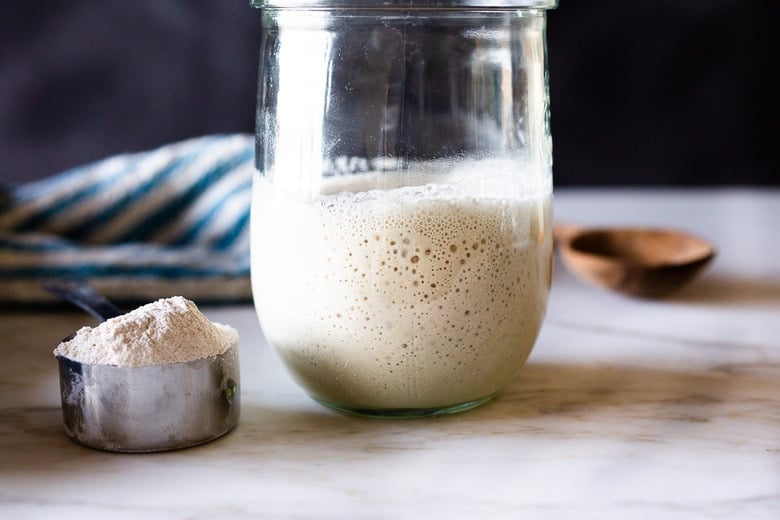
Sourdough Starter with Bread Flour Storage Tips
- REFRIGERATE & FEED AT LEAST ONCE A WEEK: Pick a scheduled day and try to stick with it, always reserving 1/2 cup and feeding it 1 cup flour and 1/2 cup water. Discard the remaining, give it away, or keep the discard in a separate container for sourdough pancakes, sourdough buns, banana bread, biscuits, etc. I usually don’t feed the discard unless I give it away.
- If you forget to feed it one week, it is most likely OK; feed it 1-2 times a day for 1-3 days in a row to revive it (keeping it out on the counter) until bubbly and active and doubles within 6 hours. I’ve left my starter for a month on vacation (in the fridge) without feeding and simply revived it by feeding it 3 days in a row, 1-2 x day. It’s surprisingly hard to kill. You can also freeze it for more extended storage.
- This batch of starter will allow you to bake 2 loaves of bread per week with enough left to feed for the next week. If you want to bake more often, you can keep it out and feed it 1-2 x daily. Or if baking every few days, you can pull it out of the fridge, feed it 10 hours before using, leaving it out, use what you need while it is peaking (or slightly after), then put it back in the fridge that evening. Do the same thing a few days later when ready to use again. So this would be feeding 2-3 times a week, best if baking 4-5 times a week.
- If you are not actively baking, you can maintain a smaller amount of starter using the same ratios.
- You can also freeze the sourdough starter if you’re leaving on a long trip.
FAQs for this Sourdough Starter Recipe with Bread Flour
Yes. While you are building your starter, during the first week, it is the simplest, easiest, fastest, and most economical way to create a healthy starter. (Or save it separately -in the fridge- and use it in Pancakes, Waffles, Buns, or Biscuits. ) This is because you always have to feed it two times its volume in flour. For example-if you kept all the 1 1/2 cups of starter, you would have to feed it 3 cups of flour (instead of keeping just a 1/2 cup and only feeding it ONE cup). Discarding will shorten the fermentation process, require less flour in the long run, and create a stronger starter. Once your starter is “established” after the first week- then you can give it away to friends or use it in pizza dough, pancakes, etc).
This recipe for Sourdough Starter takes 6 days (or up to 12 days if it is very cold where you live).
The only ingredients you need to get started are flour (bread flour and whole grain flour) and water.
What is the biggest mistake you can make with your sourdough starter?
The most common mistake is overfeeding, which weakens your starter instead of making it stronger. The secret is to watch for signs of hunger-bubbles slowing down, slide marks in the jar, or liquid on top-before feeding. Once you learn to read your starter's natural rhythm, it will stay bubbly, active, and ready to bake with.
It's surprisingly simple to make a sourdough starter! The process is hands-off and only takes a few minutes each day. The key is consistency: feed it regularly and keep it at a steady temperature. Once you get into the rhythm, caring for your starter becomes second nature, and you'll be rewarded with a healthy, bubbly culture for all your baking.
How to use Beginner Sourdough Starter
- See all our Sourdough Recipes!
- Sourdough Scones
- Sourdough Crackers
- Sourdough Biscuits
- Sourdough English Muffins
- Sourdough Tortillas!
- Vegan Banana Bread
- Overnight Sourdough Waffles
More from Feasting At Home
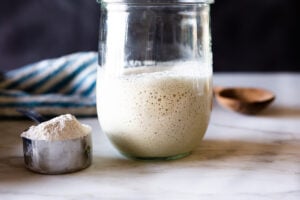
Sourdough Starter Recipe with Bread Flour
- Prep Time: 30
- Cook Time: 6 days
- Total Time: 144 hours 30 minutes
- Yield: 1 ½ cups 1x
- Category: sourdough, fermented, cultured, bread, baking,
- Method: fermented
- Cuisine: bread
- Diet: Vegan
Description
How to make your own Sourdough Starter (see the step-by-step video in post) using simple ingredients with no special equipment, in 6 days, that can be used in sourdough bread. Sourdough Starter is a wild yeast, made from fermenting flour and water.
Ingredients
- 120 grams whole grain flour (whole wheat flour, rye flour, or freshly milled flour) 1 cup, fluffed, spooned and leveled
- Organic White Bread Flour (5-10 lb bag ) I like Shepherd’s Grain or Bob’s Red Mill.
- 120 grams Water per feeding (1/2 cup water)
Instructions
-
- Day 1: Starting in the morning or at night, using a wide-mouth quart jar or Crock or Glass Measuring Cup mix 1 cup whole grain flour (120 grams) with 1/2 cup (120 grams) filtered water using a fork making sure you’ve incorporated all the dry flour. For your first measuring – it is a good idea to weigh the flour, using a kitchen scale so you get an idea of how thick it should feel. It should be like a thick paste. Thick like peanut butter. If you need to add a little more water to incorporate the flour, that is OK, but be precise with the flour. Place the lid on top (using the Weck jar is really handy here) or a damp towel to keep moisture in, or plastic wrap- and let sit at room temperature (70-80 degrees) on the kitchen counter for 24-48 hours, or until you see some bubbling. If you are not sure how warm it is, use a kitchen thermometer and check it a few hours later. See notes for TEMPERATURE.
- Day 2: After the first 24 hours, you may or may not see a bit of bubbling. I prefer to let this rest until I see a tiny bit of activity (bubbles) and sometimes this takes 36 or up to 48 hours. So start “day 2”, when you see a little bit of bubbing. Discard all but 1/2 cup (136 grams) of the starter. (See notes for discard). Add to the remainder, 1 cup of white bread flour, (120 grams), spooned and leveled, and 1/2 cup filtered water (120 grams), mixing well with a fork. Place the lid on loosely again and allow the mixture to sit at room temperature (70-80F) for another 24 hours.
- Day 3: By the third day, you should definitely see some bubbling- and if not, let it go a bit longer. Depending on how warm your house is and how active your starter, you may need to begin feeding more often, or even move to two feedings a day roughly 12 hours apart, like in the morning and at night. In a nutshell, you want to feed the starter only after it has peaked (metabolized all the flour from the last feeding) and has started sinking down or gets liquidy- this is when it is hungry! This might be 12 hours, it might be 14, it might be 18, or 24, depending on the temp in your house. In very warm climates it may only be 8 hours. It is better to underfeed rather than overfeed here. For each feeding, like before, discard all but 1/2 cup of the STARTER (keeping roughly ½-cup of starter in the jar -4 ounces or 136 grams) Add 1 cup Bread Flour (spooned and leveled) and 1/2 cup water to the 1/2 cup starter and let this rest at room temperature for 12-24 hours or until the starter looks “hungry” again before repeating.
- Day 4: Feed 1-2 times, discarding all but 1/2 cup of starter EACH TIME. Feed 1 cup bread flour, 1/2 cup water. Look for the hunger signs. Hopefully, you’ll begin to see some rising and falling. It’s helpful to put the starter in a clean jar and mark the beginning level (with sharpie, string or rubber band) so you can easily see this. ***If for some reason your starter looks like it is still rising at the time of second feeding (at night) and there is no evidence it has fallen or no slide marks, it is still “eating” so skip this feeding and feed first thing in the morning. AGAIN, Feeding it when it is “not hungry” will basically dilute all the growing yeast and make it lethargic. Better to starve than overfeed.
- Day 5: Feed again, 1-2 times, roughly 12 hours apart, or when hungry, discarding all but a 1/2 cup the starter EACH TIME. 1 cup bread flour, 1/2 cup lukewarm water. The starter should look active, bubbling, rising, sliding down, hopefully, close to doubling in size. (If not, repeat this day until starter doubles in size within 8-12 hours of feeding- and read the troubleshooting section.)
- DAY 6: Give it one last feeding. Discard all but a 1/3 cup. Add 1 cup flour ( 120 grams) and 1/2 cup water, and place it in a clean jar so you can see the action clearly. You can use a sharpie or place a rubber band around the jar to mark the beginning level. The starter should hopefully double in volume within 6 hours of feeding. When it peaks, DO THE FLOAT TEST: To test the starter, place a teaspoon of starter (just from the top, while it is peaking, don’t stir it down) in a glass full of water, it should hopefully float. If it does, you can make sourdough bread. Tonight! Let the starter keep resting at room temperature or a few more hours allowing it to fully metabolize the flour, perhaps sinking a little before making your dough. You want to make dough with slightly hungry starter. Place the remaining starter in the fridge and feed it in a week. You’ll have enough stater to make one more sourdough loaf during the week, and still have enough to feed. If you want to wait to make bread until later in the week place starter in the fridge. Be sure to feed it in 7 days. Read maintenance section.
- At this point, if your starter does not double in size don’t give up! Often it just takes longer, sometimes up to two weeks, especially if it’s cold. Continue feeding one-two times a day (only when hungry) for a few more days, until you see a visible rise and fall. Read the troubleshooting section. If you need to take a break, just put it in the fridge and try it again up to a week later. Don’t toss it- if there are bubbles, it is still alive.
- This batch of starter will make two loaves of bread with enough left over to feed for the following week.
Notes
- TEMPERATURE: The colder your home, the longer it will take for the starter to grow and become active (bubbles). Find a warm spot (70-80 degrees) for the best results. On the stovetop, with the light turned on, or on top of the fridge. Or in the oven with the light on. On top of a heating pad (set to low) with a towel in between). You can still make the starter in a colder home, it will just take longer- even up to 2 weeks.
- FLOUR: Always try to start the batch by using organic, freshly milled whole-grain flour (wheat or rye) because it has more wild yeast in it than All-Purpose or white flour and will get it active and growing sooner. You can, of course, continue to use whole grain, but I’ve had the best luck using organic “bread” flour for days 2 through 6. People have made a sourdough starter with All-Purpose flour- but personally, this has never worked for me– there are fewer nutrients and wild yeasts in the flour and results in a very lethargic starter. If it is your only option, try mixing in 2+ tablespoons of whole-grain (wheat or rye) with the AP flour per feeding. Feel free to use different flours or mix different flours together. It is OK to use all-purpose flour if in a pinch, but using it repeatedly will result in sad starter.
- WATER: I usually use tap water -but sometimes the chlorine in tap water can inhibit the growth of your starter. Lukewarm water helps fermentation to start faster. Sterilized bottled water is often overly sterile, and can also inhibit. Mineral water, like Perrier (carbonated is OK) can sometimes work miracles.
- HYDRATION: Hydration refers to the ratio of water to flour in terms of weight. It is a ratio. The starter is typically at 100% hydration- meaning equal parts flour and water, in terms of weight. So if you use 120 grams of water, use 120 grams of flour. This roughly translates to 1 cup of flour and 1/2 cup water. Feel free to weigh instead of measure if you want to be more precise, or want to familiarize yourself with the consistency you are aiming for. If using whole grain flours (which tend to be “thirstier”) and your starter seems very thick, it is totally OK to add more water to thin it a bit. I intentionally keep the hydration a little lower here (a thicker starter) so you can more clearly see the rise and fall “action” in the jar.
- STORING AND FEEDING: When your starter is kept cold, in the fridge, you don’t need to feed it as often- only once a week. Feel free to feed it “cold”, and put it right back in the fridge if you like. If you keep it out on the counter, you’ll likely need to feed it 1-2 x daily (or just watch and feed only when hungry). Cold slows down the fermentation, heat speeds it up.
- USING: When you need to use your starter for baking bread, feed it 10-12 hours before making bread dough, using it after its peak height. For a more “sour” flavored bread, use the starter straight from the fridge, 3-6 days after feeding. The starter gets more sour tasting the longer it goes without feeding. Feeding the starter the same day as making bread will produce a milder sourdough flavor.
Nutrition
- Serving Size: 1 tablespoon
- Calories: 31
- Sugar: 0 g
- Sodium: 0.2 mg
- Fat: 0.1 g
- Saturated Fat: 0 g
- Trans Fat:
- Carbohydrates: 6.2 g
- Fiber: 0.2 g
- Protein: 1 g
- Cholesterol: 0 mg
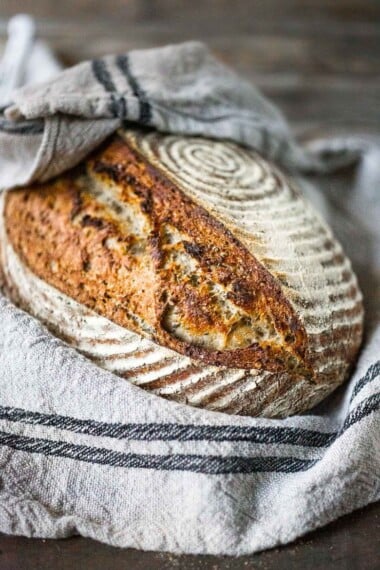

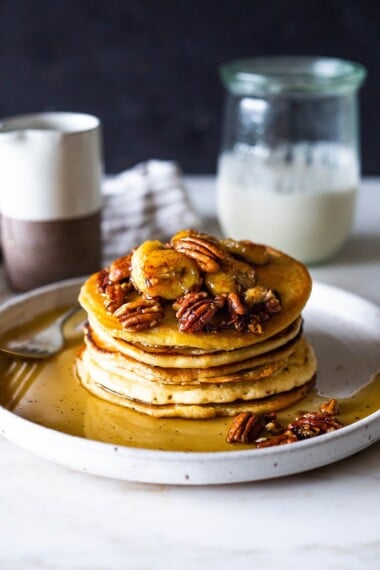
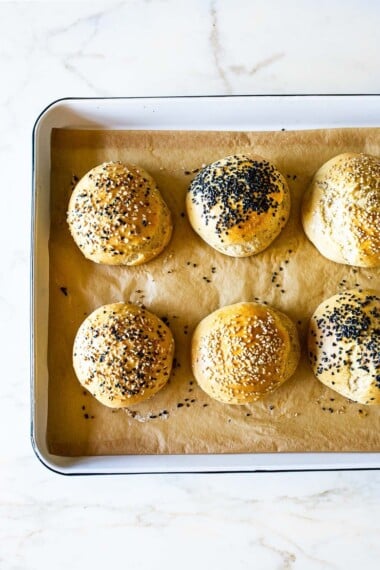








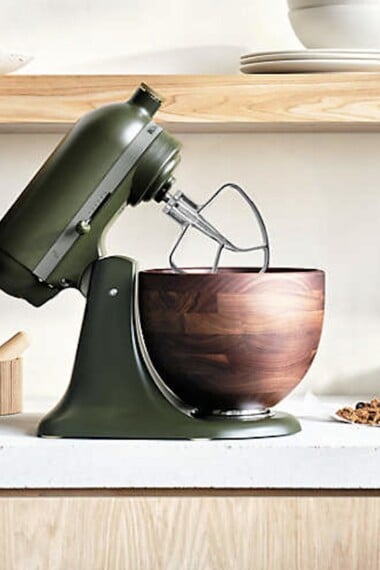
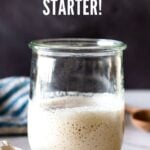
Hi Sylvia, OK, now I need some guidance. I’ve lost track of the number of days I’ve been working on my starter. The first 2 days were great and on the 3rd day, not much happened. It looked like it needed to be fed, so I did that but it took several days before I could start to feed it twice. A few days ago, I started adding some whole wheat flour to my white flour. I think I’m on about day 10. Yesterday and today, I’ve been able to feed twice. So where am I? It is rising about an inch and a half over my mark but not doubling yet. I have been diligent with temp. I found my oven with the light on is exactly 80deg. And I have not fed it before it looked hungry. I did use the discard today to make your pancake recipe, which were delicious.
Should I just keep doing this until it will double in 4-6 hrs and not worry about the number of days?
Hi Becky. Yes, don’t worry about the number of days. Just keep going. Maybe even pull it out of the oven for a day or two and see what happens. Just keep mixing it up a bit. You don’t need to feed it 2 x a day, if it doesn’t need it. If you have any other whole grain flours to try, that might be nice too.
Thank you so much! Just to clarify when it is ready or “done”, I’ll do this until it will double in 4-6 hrs and pass the float test?
Yes, or at the very least, double in 6 hours. 😉
Hello! I love the easy instructions you give, but reading through the comments I’m seeing that I’m having the same problem as a lot here with the starter going crazy with the first feed with bread flour, but then having it do seemingly nothing on subsequent days. I just did the third feed after seeing that it was very runny but it never rose or fell, and now about 15 hours later still looks exactly the same….very few bubbles (but, yes, some very tiny ones down inside the starter) and absolutely flat. My first try ended up smelling horrible, like a chemically smell, which reading through the comments also sounds like that was just a time it was VERY hungry, but I wasn’t sure so I dumped it and started this second try. I also have a question I haven’t seen come up yet. Is it more important to go by exact weight (120 g of flour) or a heaping cup? Because for me, a heaping cup is WAY more than 120 g. So, wondering if it’s better to see a thicker consistency with a feeding, or a little looser consistency but with the exact weight of flour/water. My house stays at about 70-72 during the day, but at night it gets colder so I stick it in the oven with the light on. I’m thinking I just need to be more patient, but I definitely haven’t gotten to where it seems to need two feedings a day. One more question…I picked up some organic bread flour but realized it says ‘enriched’ and wonder if that would be okay to use or not. I haven’t used it yet. Thank you for your help!
Weight is always more precise. The recipe has been updated to not say “heaping cup”. You want a slightly thick consistancy- to help you notice the rise more clearly. Try the flour and see what happens?
Thank you!
Hi, thanks for the starter recipe! I’m wondering if I cut the recipe in half will it work? ie I start with 60g flour and water. And keep going with 60g of flour and water. And everything halved the recipe above thereafter. Thank you!
I think that should be fine?
Hi Sylvia! I am on day 3 of this starter and it has at least doubled in size in my jar… if I’m understanding correctly, I should wait until it is going back down before I feed alit again? Just want to clarify as it has been probably about 18 hours since the last feed and it just seems to be growing!
Yes wait until it starts sinking 🙂
I live up north in Minnesota so it is very cool up here. Do I skip the directions for each of the 6 days and just go by how it looks acccor to your video? I have a jar going now but its barely rising. I do see the bubbles you are talking about but I am not getting much rise.
If it is very cold, yes, just watch the starter and feed when it seems hungry. It will take most likely longer than the proposed schedule.
Well, sticking the starter in the over with the light on and using King Arthur Bread Flour did the trick. When ingot up this morning it was double in size! My next question, which day do I start with now since I never did have the chance to feed it even twice a day?
How many days has it been total?
Ranee, I’m in St. Paul, MN. I used this recipe but it too me about 8-9 days total because it was cooler… and that was this past September. Hang in there because around the 8th day my starter exploded and is still very healthy.
Hi Sylvia and Ranee,
How do you know when your starter is ready if you’re not following the instruction?
My starter had not move on day 2 morning so I’ve delayed the feed till 4pm. (it had double in size by then)
On day 3 I fed it at 10 am but think it was too early, it had bubbles and had risen but not that much and had no mark on the side.
I haven’t done the second feed of day 3 because, it doesn’t seems to rise anymore.
I’m on day 4 afternoon and it has risen very very little but is bubbling still.
How do we know the starter will be ready for bread making? is it after a having done all the feeds? or numbers of day?
Hi Christelle- please refer to the instructions and trouble shooting section. Thanks.
Great!
I did a couple things to help it along that was mentioned here and now, like you said, it exploded 🙂
I put it in the oven with the light on and I also bought some king authur bread flour.
Thanks for everyone’s help!
As of the 9th its been 11 days.
Thank you so much for your quick response and answering every one!
Such an awesome site! I just love it!
PS – I’m also using non-filtered well water, which may also pose its own set of curiosities, I’ll let you know –
Yes, probably a good thing though!
Hi! I am so excited to try this. I’m on day 3 – have had to adjust the measurements to make it the right consistency, as well as purchase a seed warming mat, as my kitchen is cold (which made it rise right out of the jar on day 2 :). I expect there will many tweaks to learn, but my most burning question is about the smell. Is there any indication here I should be aware of to tell me it’s bad?
It should smell, slightly earthy and sweet- if it smells like acetone, it is time to feed it. 🙂
Thank you so much for your very detailed instructions. I have been wanting to make a sourdough starter for quite sometime. I have always felt so intimidated but with your great recipe, tips and videos, I finally did it and successfully made my starter and first loaf of bread!! So rewarding, thank you again!
Great to hear!
Hi Sylvia! Love your site. Cook out of often. My question is can I use gluten free flour(s) for making a sourdough starter? Thanks in advance.
I don’t see why it wouldn’t work but haven’t tried it personally. Let me know how it goes Rita…very curious!
Hi! Is there any way you could send me your video? I’ve tried two different devices and 4 different explorers and can’t get it to load. I’ve checked and my ad blockers are off.
HI Nicole, I’m so sorry I can’t send it. I’ve tried the file is too big. Have you tried on your phone? That might work??
Thanks!
Thank you for your great article. It is very informative.
This is my first time making sourdough starter and I’m not sure what I’m doing wrong. I started a batch two weeks ago and threw it all away because nothing rose and it smelled funny on day 6.
I now have two batches going, to see what my results would be. They are both a day apart. Started with organic whole grain for both. Doubled in size before 48 hours for both of them.
Then used organic bread flour for days 2-6 and it hasn’t risen at all. Plenty of bubbles and runny liquid on top.
Day 6 on one, tried float test and it sunk to the bottom. Day 7 on the other tried the float test and it too sunk to the bottom. What am I doing wrong? Should I just change back to organic whole grain seeing as though I got great rising action from both jars?
Try mixing in some whole grain with the bread flour? It doesn’t sound like you are doing anything wrong. The float test isn’t essential but you should see rising and falling eventually. It takes longer when cold so just keep on going, only feeding when hungry. 🙂
Great recipe. Please change your text/blog as you often say ‘so’ at the beginning of sentences…….annoying
So annoying. Only kidding. I couldn’t resist.. 😂 😉
Can you use any flour? I have strong white bread flour I was going to try it with. Thank you
Give it a try. Use a whole grain to start though if possible.
Does the mason jar have to be kept in 70°-80°F for the entire day or just for half of it? In where I live, it’s under 80°F for only 12 hours every day.
They don’t have to- but if warmer than that you may need to feed more often.
Hi, Sylvia. Thank you SO MUCH for your extremely detailed instructions and videos! I also appreciate that yours is an active site, and that you continually answer newbie questions. This is my first time making sourdough starter. I have some questions…
Day 2 came and went with much bubbling and rising. However, Day 3 seemed a dud. I read your troubleshooting section again, and it said that if I have a liquid on top, and the starter is thin enough to pour, it’s hungry. So I just want to check with you that, as you said the “instructions” are a rough guideline for US not the starter, I need to feed it at least once a day, even if it’s not rising and falling? And I keep doing that until it IS regularly rising and falling?
My next question is about flour. The whole wheat flour I use is organic, but the bread flour is not, although it is unbleached. You specified organic often, but is that a personal preference, or do the yeasts need organic? I know with other things I culture, I have to use organic ingredients so there is no sulfur.
Thanks in advance for your help!
Hi Karyn, the instructions are a rough guide for yes US, but always watch your starter. It will tell you when to feed it. No, you don’t need to stick to once a day. Only feed when hungry. It may not rise and fall, but it still may get runny and liquidy- or have a layer of liquid on top- all signs of hunger. Better to underfeed than overfeed here. In cold weather, this whole process may take longer. So just be patient and watch the starter. So I have not always had the best luck with bread flour that is not organic and I’m not sure why. Maybe there is less wild yeast in flour that is not organic. But feel free to try it. If it is consistently not producing a rise, add a little whole wheat to it, or do an entire feeding with whole wheat.
Sylvia, I ended up dumping my original batch. It started to get the acetone smell, which, I know from other things that I culture, the pH of my grains was off, either from non-organic flours or chlorine in the filtered water.
So I started over with pure organic flours and spring water. It’s Day 2 and my starter has almost doubled in 8 hours!
I think I have a winning combination.
I just have one question right now as I haven’t delved into making this just yet. In the recipe and the video on the last day of feeding, you used 1/3c. Starter instead of 1/2c. I was just wondering why.
Thank you for making these great videos and step by step instructions! Very well done!
Thanks Becky, yes 1/3 starter on the last day- it gets a little more “food” that way. A little boost.
Hi Sylvia!
Last night my starter bubbled over so I left it overnight to “deflate” and it did sink all the way down. (It has never been refridgated & I feed it twice a day if i see slides) At 10am this morning I fed it and it is now 1:45 in the afternoon and is about to bubble over again! I use the Weck jars and it has never done this before. I was hoping to make a loaf of bread tonight but wow I’m sure I’ll have a mess on my hands. It’s very bubbly with lots of holes. what should I do? Stir it down? take some out and try baking bread or just let it bubble over again? I don’t know why it’s doing this?should I cut the recipe, should I get a bigger jar? I wish I could send you pics
thanks kim
How old is your starter? If it is older than 6 days, you can make bread. Don’t feed the amount you’ll use make the dough with. Feed the remaining (1/2 cup) and put it in the fridge?
Had to leave my starter in the fridge without feeding probably a good 4 to 6 weeks. It smells super vinegar-y and the liquid up top is kind of green-ish but definitely no mold spots. I just fed it, do you think it’s safe to continue to feed? I put it back in the fridge after feeding should I keep it on the counter for the next couple days and feed 2 to 3 times a day or is it okay in the fridge?
If you plan to bake with it soon, I would leave it out a few days, feeding as necessary to build it bakc up. If you are not baking soon, then feed once a week and leave in the fridge.
It took a little longer than expected but we got there. After storing the starter in the fridge for a week we took it out and fed it. It’s very liquidy at top but it didn’t rise at all, should we still feed it?
It it seems loose enough to pour out of the jar, then feed it. 🙂
On day 2 and my 4cup jar overflowed 5 hours after i fed it. Should i wait the whole 24hrs to feed again? Thank you
I’d wait until it sinks all the way down.
Thank you for such a detailed post it has been very helpful! I just have some concerns, as my starter on day 2 doubled and then after feeding on day 3 it barely rose at all. Rather than feeding it 12 hours later like your instructions said I left it for 24 hours hoping it would rise and show more signs of hunger but it stayed the same. I have just fed it now and am wondering if it is saveable? Is there anything else I should do? Thanks!
Maybe try switching up your flour if you don’t see any rise after a couple days.
Hi there thankyou for the informative intructions. I have used organic spelt wholegrain flour to start with but in the following days can i use regular white bakers flour? I dont think its organic. Otherwise should i stick woth the organic spelt wholegrain for the whole starter process? Thankyou
I think. you’ll have the best luck with the organic spelt, but there is no harm in blending the flours or trying the other one- you can switch back and forth and judge by the activity and decide which is best here.
Hi Sylvia, my sourdough is 5 months old right now. I have used your recipe for bread and have made many amazing loafs.
I didn’t feed my starter that has been in the fridge for 1.5 weeks since I was gone. Prior to that I have been feeding it every 1 week since June. I decided to feed it at 1.5 weeks and left it on the counter for roughly 10 hrs. At 10 hrs I saw only bubbles and no rise. I fed it again and left it on the counter overnight and this morning still no rise and only bubbles. In the past when I have left it on the counter, I usually see it rise. Is my starter dead? Should I just put it back in the fridge? I don’t want to lose this starter 🙁
It is not dead, just be patient. Keep feeding it, only when hungry. 🙂 Try different flours if need be.
Hi! I’m on day 4 and this is coming along so well! Thank you.
On Friday (day 6) I need to leave my home by 6 am and I will likely not be home until 9 pm. Luckily this is the day with only one feeding. In instructions you say to feed and wait hours and do the float test. I will definitely not be home within 8 hours more like 13-15 hours. When I get home should I do the float test and then start the overnight process if it floats? Will it be too late regardless?
If it doesn’t float is it too late? I’m assuming I should continue to feed it until it does float, but just want to make sure that the 8 hours isn’t a firm window. Thank you!
That is fine, try the float test after you get back, or just extend the process one more day.
Hi! I did the float test before I left and it floated. Then I came back and decided to extend for one more day. I mixed in spelt flour instead of bread flour because I was out of bread flour. It’s alive and well (doubling in size) and bubbling but it’s not floating. So bummed. I was there and I missed it. So I am thinking I will feed it tonight per usual but bringing it back to bread flour. Thoughts?
I think it should be fine. Dont worry about the floating- people are telling me they are making beautiful loaves without it floating??
Ok I fed it with brad flour again. I’ll do one more feeding tomorrow. Then I’ll prepare it tomorrow night. It’s like having a baby. Haha. Thank you!
Easy to understand recipe and well explained also FAQs were taken up
Oh my. I am on day 3 and I am out of bread flour. Can I use all purpose organic flour or whole wheat flour to feed? Thank you! I love your direction!
I’d use the whole wheat.